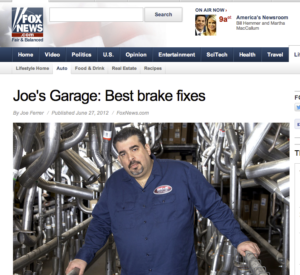 I had a lot of hope for the show “Hard Parts: South Bronx” on Speed TV when it first came out. Parts stores can be an interesting place, there is drama and some good story lines. But, Hard Parts makes the profesional counterman look like a bunch of ignorent idiots and thugs. Instead of concentrating on BF&S professional customers, the show turns the counterman’s job into a circus act with outlandish customers looking for parts that most part stores tell the person to GTFO.
I had a lot of hope for the show “Hard Parts: South Bronx” on Speed TV when it first came out. Parts stores can be an interesting place, there is drama and some good story lines. But, Hard Parts makes the profesional counterman look like a bunch of ignorent idiots and thugs. Instead of concentrating on BF&S professional customers, the show turns the counterman’s job into a circus act with outlandish customers looking for parts that most part stores tell the person to GTFO.
Joe Ferrer is the owner of BF&S and is being turned into a spokesperson for the automotive service industry by Fox. But, maybe they should have their fact checkers check out this comment by Joe:
-Joe Ferrer, owner BF&S Auto Parts, on FOX News
OK Joe, you are wrong. What causes pulsation is lateral runout, now let’s do some math. Let’s say the vehicle had .003-inch of lateral runout when measured at the outside face of the rotor. If this vehicle is riding on 205/55R16 tires, in one mile, the high-spot with .003-inch of runout goes past the caliper approximately 836 times. Over 6,000 miles, that spot on the rotor will go past the pads more than five million times! Every time this spot passes the pads, a little bit of the rotor’s material is removed. Over five million revolutions, enough material is removed to create a thickness variation that can be felt by the driver.
In the scenario, I never used the word “warped.” The words “warped” and “warping” should never be applied to brake systems.
In the scenario, there is no twisting or bending. There is only wear and changes in the dimensions of the rotor. Heat was not a force distorting the rotor by softening the metal. The heat used to cast the rotor is three to five times greater than the heat produced in the most aggressive braking down a mountain road. Most engineers will tell you, rotors will crack long before they are distorted by heat.
Sure, a customer can experience a pulsation or judder after higher-than-normal brake temperatures are experienced. About 99 percent of the time it is not the fault of the rotor; it is the pads. The pad’s friction material has been unevenly deposited around the face of the rotor. This creates uneven braking forces as the dissimilar sections pass by the pads. This type of pulsation or “judder” will typical go away after a few hundred miles.
I don’t know if Joe is trying to boost rotor sales, but get your facts straight.
Here are some great articles on the topic:
Don’t Blame the Rotors-Counterman Magazine
Comments are closed.